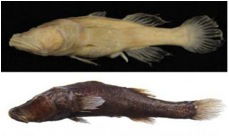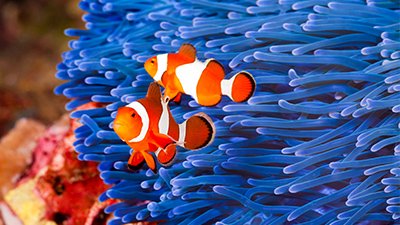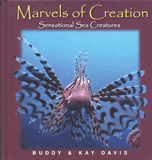
Blind Cavefish Cousins in Favor of Flood Geology Model
Blind cavefish cousins provide evidence consistent with Flood geology model of earth’s history.
News Source
- Naturenplanet: “Australia’s Eyeless Fish Have Cousins in Madagascar”
Cavefish confined by their blindness and dependence on the freshwater environments of their native caves can’t exactly go wandering around the world. Now, a genetic analysis of blind goby fish from Madagascar and Australia—separated by about 6,000 miles of ocean—shows that the fish are cousins. Scientists say this is strong support for the fact that southern landmasses were once combined as a supercontinent, which they call Gondwana.
“This is the first time that a taxonomically robust study has shown that blind cave vertebrates on either side of an ocean are each other's closest relatives,” says lead author Prosanta Chakrabarty of Louisiana State University's Museum of Natural Science. “This is a great example of biology informing geology. Often, that's how things work. These animals have no eyes and live in isolated freshwater caves, so it is highly unlikely they could have crossed oceans to inhabit new environments.”

Eyeless and colorless, this Madagascan cave goby’s long lost cousins, confirmed by genetic analysis, have been found in Australian caves. Image from BBC.1

The blind goby from Madagascar, pictured on top, not only has an Australian cousin, it also shares its Madagascan environs with a colorful member of its own genus, shown below. The colorful species is as yet unnamed. Image by AMNH/J. Sparks, via American Museum of Natural History.2
As a bonus, researchers discovered a darkly pigmented variety of the blind Madagascar fish—a colorful cousin, yet unnamed. They believe it evolved from the unpigmented version. “It has generally been thought that cave organisms are unable to evolve to live in other environments, in other words to ‘reverse’ their specializations for a subterranean life,” co-author John Sparks of the American Museum of Natural History says. “Our results, and the fact that we have recently discovered new cavefish species in both Madagascar and Australia belonging to these genera, are intriguing from another perspective: they show that caves are not so-called ‘evolutionary dead ends.’”
Genetic analysis demonstrated the Australian and Madagascar versions of this fish, though they have different genus names, are genetically similar and appear to suffer from the same sight-costing mutation. Thus they apparently share a common ancestral goby fish. In an effort to pinpoint the timing of their divergence, however, the researchers relied on circular reasoning by which molecular clock data is interpreted on the basis of unknown past mutation rates and the fossil record. Since both depend on unverifiable uniformitarian assumptions inherent in the long-age interpretation of radiometric data, the vast ages (45–110 million years) calculated for the fish’s ancestral divergence are flawed.
Blind colorless cavefish, such as these gobies, are sometimes put forth as evidence for evolution. As the researchers write, “Blindness and reduced eyes have evolved rarely in fishes and in gobies in particular (which contains more than 2200 species).”3 Living in dark caves, they have no need for sight or pigmented coloration to protect them from the sun or to attract mates.
Blind fish don’t demonstrate evolution. They are just mutated varieties of fish. The ordinary process of natural selection and other processes can explain their presence in dark caves unsuited to similar sighted varieties of the same kind of fish. In this sin-cursed world, mutations destroy genetic information, but mutations preventing normal eye development would not be a problem for fish living in perpetual darkness. Such mutations would not be selected against. Why? Because, in such darkness, vision would not help fish find food. Some species are even known to have their other senses heightened. Thus a population of the blind fish could easily develop and thrive in the dark, but not in the light. Such a process would not require extraordinary spans of time. Speciation commonly occurs rapidly and observably. And such a process certainly is no example of molecules-to-man evolution. Fish they were and fish they are, just fish with less functional genetic information than before.
The discovery of a pigmented version of the fish should also be no surprise, as it represents not the evolution of new information but a variant of the genetic information already present in the genome of goby fish. Its pigment is not proof that new genetic information can be acquired in caves (or anywhere else). Furthermore, pigmentation would offer no selective advantage in a cave. And neither pigmentation nor the lack of it would be selected against in a perpetually dark environment.
These findings are . . . consistent with the existence of a transitory supercontinent during the Flood.
These findings are, of course, consistent with the existence of a transitory supercontinent during the Flood. Such landmasses are consistent with models of Flood geology. We do not need evolutionary timescales to explain the breakup of such a landmass. Simulations of the tectonic activity associated with the global Flood explain the catastrophic breakup. Read more about it at “A Catastrophic Breakup.”4
Since God created all things including all kinds of fish in the beginning, it is no surprise that goby fish share a common ancestor—a created fish from which they descended, not a non-fish from which they evolved. These goby fish are found in limestone caves carved in Flood-deposited sedimentary rock. It may well be that the goby ancestor of these blind gobies mutated and established a blind population prior to the Flood or even during the severe environmental pressures of the Flood year. Then, surviving in these cave refuges, the population may have been separated within a matter of months by the dramatic changes in earth's geography associated with the Flood.
Further Reading
- A Catastrophic Breakup
- Can Catastrophic Plate Tectonics Explain Flood Geology?
- Are Mutations Part of the “Engine” of Evolution?
- 4.2 “Each According to Its Kind” (OB14)
- News to Note, December 31, 2011: Year in Review (“Circular clocks”)
For More Information: Get Answers
Remember, if you see a news story that might merit some attention, let us know about it! (Note: if the story originates from the Associated Press, FOX News, MSNBC, the New York Times, or another major national media outlet, we will most likely have already heard about it.) And thanks to all of our readers who have submitted great news tips to us. If you didn’t catch all the latest News to Know, why not take a look to see what you’ve missed?
(Please note that links will take you directly to the source. Answers in Genesis is not responsible for content on the websites to which we refer. For more information, please see our Privacy Policy.)
Footnotes
- Jonathan Ball, “Goby Fish 6,000km Apart Share Eyeless Common Ancestor,” BBC, August 31, 2012, http://www.bbc.com/news/science-environment-19440500.
- “Eyeless Cave Fish ‘Sisters’ Found on Opposite Sides of the Indian Ocean,” American Museum of Natural History, August 30, 2012, http://www.amnh.org/explore/news-blogs/research-posts/eyeless-australian-cave-fishes-closest-relatives-in-madagascar.
- Prosanta Chakrabarty, Matthew P. Davis, John S. Sparks, “The First Record of a Trans-Oceanic Sister-Group Relationship between Obligate Vertebrate Troglobites,” PLOS One, August 28, 2012, doi:10.1371/journal.pone.0044083.
- Gondwana was part of the initial assembly of southern continents during the Flood that, in Flood geology models, then joined with Laurasia to become Pangea.
Recommended Resources

Answers in Genesis is an apologetics ministry, dedicated to helping Christians defend their faith and proclaim the good news of Jesus Christ.
- Customer Service 800.778.3390
- © 2024 Answers in Genesis





